Peter MALONE
Brand Bollywood...downunder
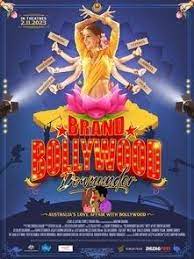
BRAND BOLLYWOOD… down under
Australia, 2023, 93 minutes, Colour.
Directed by Anupam Sharma.
An interesting and entertaining documentary, especially for movie buffs, but beyond… A subtitle: Australian’s love affair with Bollywood.
The screenplay points out that the biggest group of migrants to Australia after the British is the Indian migration. Which means that this is a documentary both for Australia and for India.
In fact, the film has three special focal points. First, there is cinema itself. Secondly, issues of trade and tourism between the two nations. And, thirdly, issues of culture and cross culture. And, within its hour and a half, all of these issues are dramatised and challenged.
The director himself, Anupam Sharma, of Indian background, graduated from the University of New South Wales, has been involved in the film industry since the 1990s, as producer, and director of several films including the Brett Lee cricket comedy, UNindian.
And on the title – for decades now, Bollywood is the general title for Indian cinema (and, it is rightly pointed out that this is not accurate, applying to Mumbai cinema and its singing and dancing style, but not really applicable to cinema from such centres as Kolkota, Chennai,). But, there are plenty of excerpts from Bollywood movies throughout the film – and quite a long final credits song and dance to keep us in the mood.
Indian culture has been for millennia a culture of images, paintings, statuary. And, very early in the history of contemporary cinema, Indian filmmakers realised its potential. The first 30 minutes of this film offers a very interesting, sometimes illuminating, history of cinema in India, quite striking silent film footage and, for Australians, the story of Mary Ann Evans from Perth who went from Australia to India, worked in and circus, and in the 30s became quite a movie superhero figure, Fearless Nadia (and clips from her films to definitively prove this).
Indian filmmakers had come to Australia but this developed during the latter part of the 1990s, again many clips to highlight the scenarios, and Indian characters photographed often on Sydney Harbour Bridge, in the outback, with kangaroos…
Which leads to the second issue of trade and tourism, Indian audiences fascinated by what they saw with the movies made in Australia, wanting to visit. And, with the filmmaking, possibilities for trade and industry development. To highlight this, South Australian Labor Premier, Mike Rann, invited India to South Australia and, for a time, a centre for India-Australia films. But then the emphasis moved to Victoria, especially with Liberal Premier Ted Baillieu, enthusiastically welcoming India – and both Premiers persuaded to join dances on stage and display the rhythmic movements!
There is also the issue of Intermission, always during Indian screenings for some mid--movie socialising.
So, a great deal of cross-cultural interactions. But, a number of tensions. Filmmaking style in Indian studios seems loud, brash, everybody involved, contrasting with a more disciplined practical approach in Australian studios. But, the film also emphasises some sad events in Australia, murders of Indian students in Australia, media attacks on Australia, doyen of Indian actors, Amitabh Bachchan, publicly refusing an honorary degree from the University of Queensland (but, with more dialogue and more collaboration, accepting the degree eventually and coming to Australia for a cameo in Baz Luhrmann’s The Great Gatsby).
There is a Bollywood festival in Australia. Many cinemas program Indian films – and there is no lack of films from India which has the largest film industry in the world.
So, an urge to creative cinema collaboration.
There's Something in the Barn
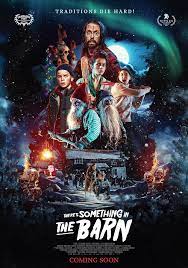
THERE’S SOMETHING IN THE BARN
Norway, 2023, 100 minutes, Colour.
Martin Starr, and Amrita Acharia 26, Townes Bunner, Zoe Winther-Hansen, Jeppe Beck Laursen, Kiran Shah, Henrietta Steenstrup
Directed by Magnus Martens.
In fact, there is, rather, someone in the barn. And, as the story progresses many more someones in the barn – and breaking out.
This Norwegian film is, perhaps, best described as comedy-horror, the kind of film that is light entertainment in the programming of a horror festival. Much of it is played for laughs, but there are increasing horror confrontations (and, rather shamelessly, this reviewer got the biggest laugh by the sudden appearance of a semitrailer with disastrous results).
With its beautiful winter snowy scenery, Norway looks very attractive for a touristic visit. But, with mayhem in the barn, overflowing into the house and out into the snow, prospective tourists might have hesitation despite the fine display at the end of the beauty of the aurora borealis.
We have a warning right at the prologue, disaster in the barn, the owner going up in flames, and, causing shocks and observing a Norwegian gnome, garden decorative variety but with grizzled ancient face, sounding dialect, named throughout the film a “barn-elf”.
And, breezily into this Norwegian December countryside comes an American family, who have inherited the house and the barn, intending to turn it into a hotel. Dad is ultra-breezy American, ultra-ingenuous as it turns out, a widower who has married a young happiness coach. Two children, a 16-year-old girl who wishes to be anywhere but here and, as it turns out, a sensible young son.
They drive into town, loudly greeting everyone, somewhat ignored because, as explained, Norwegians have a tough exterior but, when it melts, they have heart. (And alcohol is a great melter of the exterior.) The serious son is intrigued by a museum for barn elves and gets a lot of information from the proprietor, three rules to keep in mind: they dislike big lights, they dislike change, they dislike noise. Of course, this will cause mayhem – but also may help in the taken defence when the mayhem takes over.
But, the young boy makes friends with the main barn-elf who, when on-side, clears paths through the snow, chops and stacks would… Though he has his angry moments, he will turn out to be a saviour, finally finding refuge in a cottage at the town’s Museum. And, there is a friendly middle-aged woman cop, no gun, Norwegian-cheerful, interrupted by events on Christmas Eve from her cooking dinner and watching Love, Actually!
And, throughout the screenplay, there are lots of comic shots at American attitudes, especially when the father is desperate for a gun and that is not the Norwegian way, quips about Americans, guns, shooting people in the face. But, there are some quips about Norwegian peace, the reputation for negotiations and peace deals, especially Oslo, though not always successful.
Which means then that this is a kind of horror film with an almost PG rating! Horror fans may get impatient with the humour. But, audiences wanting something different, accepting something slight, the premise and some of the execution (a word used advisedly for what happens to so many of the barn-elves), might enjoy the hundred minutes.
- Comedy? Exuberance? Americans abroad in Norway? Horror? The barn, the elves, the rules, destruction? The combination?
- A Norwegian story? An American story? The location photography, winter, snow landscapes, the mountains, the house and interiors, the barn and interiors, the town, the diner, the elf Museum? The countryside, the highways? Authentic feel?
- The prologue, the farmer, deciding to destroy the barn, the mysterious presence, the fire and his death? Leaving the house and barn to his nephew?
- The ultra-exuberant American family, cheerful, loud? Bill, widower, his children, the encounter with Carol, Happiness Training, her enthusiasm, her techniques? Nora, 16, sulky, not wanting to be there, phoning friends? Lucas, his age, quieter, common sense? The ambition of turning the barn into a hotel? Settling into the house, going to the town, loud, meeting Ronnie, Lucas and the proprietor of the elf Museum, learning the rules?
- Lucas, in the barn, the mysterious sounds, meeting the elf, offering the biscuit, the appearance of the elf, age, grizzled face, Norwegian mumblings, hand on heart, the elf clearing the snow path, stacking the wood the Bill? But the rules of no Bright lights, no change, no loud noises? And porridge with cinnamon and butter as a peace offering a Christmas?
- The decision to socialise, invitations to the party, handing them out in the town, the preparations? Everybody arriving, Norwegian frosty exterior, alcohol met melting the exterior, the warm hearts?
- Bill, the cookbook, the fish, no be able to eat it? Lucas and his preparing the porridge gift? Bill eating at all? The beginning of disaster? Lucas giving the elf the fish, failure?
- The party, the Santa Claus decorations, Ron coming as Santa Claus, loud? The lights? The attack by the elves? The visit of the sheriff, her being cheery, no gun, watching Love, Actually? And the shock of the crash and her death?
- The emergence of the elves, the large number, the attack, the family under siege, the fights, Carol and her techniques, Bill and his dithering, Nora and her fighting, Lucas trying to make peace? The comedy of destruction? The Moose (and the initial photo &)? Bill and Lucas, the sled, the pursuit, the semitrailer ploughing into the elves?
- Ingenuity, reconciliation between Carolyn Nora, working together? Captured?
- Going to town, the museum proprietor, delaying and leaving, the discovery of the underground tunnels, the release of Carol and Nora? The pursuit?
- The friendly elf, loyal to Lucas, hand on heart, helping, the explosives, the fire, destruction?
- The proprietor, his philosophy of peacekeeping, Norwegians as peacekeepers, his offering a home to the good elf?
- The combination of horror and comedy?
Hijacked: Flight 73
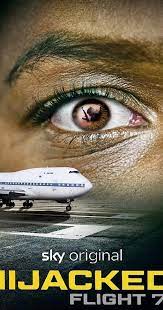
HIJACKED: FLIGHT 73
UK, 2023, 94 minutes, Colour.
Directed by Ben Anthony.
A 21st-century documentary and perspective on terrorist hijackings of planes in the latter part of the 20th century. There had been cruise ship hijackings, the Achille Lauro, an increasing number of playing hijackings, especially at Entebbe in 1977. This is the story of the hijacking of a Pan Am plane, originating in India, stopping for refuelling in Karachi and hijacked by Palestinian terrorists. The hijacking of Lockerbie was soon to come, implicating Libya and Colonel Gaddafi in the overall planning of terrorism with American attempts at bombings and retaliation. And, ultimately, there was 9/11.
The first part of the film shows the flight and the passengers, the takeover by the terrorists while they were at the airport in Karachi, their behaviour with the passengers, the attempted communication with the Pakistani authorities, the breakdown of communication, the fear of the passengers, the role of the flight attendants, the crew following orders and escaping from the cockpit so that there was no one to fly the plane onto Cyprus which was the stated intent of the terrorists. The hijacking was meant to be a demonstration against Americans but the flight attendant collecting the passports hid the American passports. The hours wore on, the music was Scott Joplin’s The Entertainer, played over and over and over, the passenger’s huddling, a British passenger taken as a possible mediator. There is also the authority at the Karachi airport and his attempts to dialogue, the subsequent shooting one of the passengers, and the poor response of the Pakistani government and the authorities at the airport.
A lot of this is brought vividly to life by re-enactment, establishing for the audience a sense of being there, identifying with the passengers, the terror, the hours, the board, the eventual shootings.
The documentary also has interviews for the making of the film by a number of people who were on the plane, especially to flight attendants who are able to describe what happened, their memories of what happened. There is also the British man explaining why he was on the plane, after the accidental death of his brother in the mountains. There is a man from Seattle, a terrified boy on the plane, playing with the child in the next seat, experiencing the death of the child. There are two sisters, Indians, remembering their brother and his wanting to attack, his eventual death. And, very sympathetically, there is the official from the airport trying to do his best, thwarted by the government authorities and their ill judged decisions.
After the audience experiences the hijacking, and has listened to the testimonies of those on board, appreciating seeing them in later years and their expressing their feelings at the time and since, there is a lot of evidence about the Pakistani government, incompetence, false storyies about a commando raid (and, throughout, a lot of footage from the news reporting of the time, even the president of Pakistani giving praise to how the situation was handled. Quite false.
But, the film continues with the capture of the terrorists after the wild shooting within the plane and the passengers escaping by the chutes, as do the terrorists who are then captured, tried and sent to jail. Then 15 years later, the chief terrorist is released from Pakistan, captured by the Americans, tried in an American court and condemned to life imprisonment – not long before 9/11.
A number of the witnesses were filmed attending the trial, expressing their feelings after 15 years.
There is a finale with the British passenger, reflecting on his brother’s death being the occasion for the flight, the chief terrorist being sympathetic towards him and sending him back to his seat in the plane, wanting to contact the terrorist, phoning the prison, and the recording of a conversation between the two, the terrorist expressing some remorse, explaining his situation where he was at the time, his motivations, and the intention of the hijacking to be a suicide crash (as happened with 9/11).
The film was released in April 2023 and appeared on streaming services in Australia in October 2023, at the very time of the Hamas attack on Israel and Israel’s war on Gaza.
Locust/ Iran

THE LOCUST
Iran, 2022, 78 minutes, Colour.
Hanieh Tavassoli, Pegah Ahangarani, Pedram Sharigi, Shirin Aghakashi.
Directed by Faezeh Azizkhani.
This is a small film made by a writer-director who had made only one film previously, seven years earlier. This is a film about the difficulties in getting a film made.
The film opens with a five minute sequence in a car, echoes of Abbas Kierostami, a screenwriter driving to pick up her producer, talking to camera, watching a policeman riding a bike, continually passing him. She then picks up the producer, and difficulties begin.
The couple arrives at a home, various members of the production having gathered, the rest of the film illustrating the difficulties, the contradictions, the power struggles, people shouting at each other, members of the family criticising the writer for her perspectives on the family, the arrival of her mother, the tension with her mother, the issue of selling the house to raise money – and, when there might have been some kind of movement towards agreement and the possibilities of shooting the film, their financial producer is arrested for money deals and embezzlement.
There is no real solution to the dilemma. The film can’t be made. The writer, with something of a prickly personality, easily alienating others, clashing with her mother, has a loud scream of frustration.
There are voices, her ghostly father, and symbolic rooster strutting around the house. However, as the family and the others begin to disperse, she has some kind of reconciliation with her mother. She is then seen driving again, passing men on bicycles, one carrying a bargain basket of roosters.
It would seem that the only way the writer-director can get a film made is making a film about her struggles.
And the King Said: What a Fantastic Machine
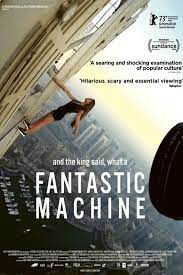
AND THE KING SAID: WHAT A FANTASTIC MACHINE
Denmark, Sweden, 2023, 88 minutes, Colour.
Directed by Axel Danielson, Maximilian Van Aertryk.
In just under an hour and a half, this documentary sweeps over the history of photography, cinema, television, social media. Some have noted that it is a celebration. Others that it is a homage.
The summary synopsis best describes it:
From the first camera to 45 billion cameras worldwide today, the visual sociologist filmmakers widen their lens to expose both humanity's unique obsession with the camera's image and the social consequences that lay ahead.
It is interesting to note that the writers-directors are called visual sociologist filmmakers. This film is in no way an equivalent of a visual sociological thesis. Rather, it is illustrated, highlights picked out, jumping about in chronology, moving from one country to another, something of a 90 minutes, display of the themes. While it is enjoyable, with so much visual material to appreciate, respond to, relish, and, and so many questions and issues raised, it does not give the audience much time to reflect as they watch.
Depending on attitudes towards photography, television watching, the commercialisation of media, slick packaging, the difference between programs and shows, points of view will be reinforced or irritated. One blogger summed it up: just a kaleidoscopical and anecdotical series of ideas. JvH843.
With that said as something of a caution, or an alert to an audience keen on an overview of the visual capturing of images, there is a lot of material that is striking. For instance, going back to the original photo in 1828, Daguere and developments, the camera obscura moving to cameras, Muybridge and the galloping horse, the Lumiere Brothers and their screening of their one-minute capturing of daily realities, to the British William Friese-Greene (with generous clips from the 1951, The Magic Box, Robert Donat in the title, showing a film of Hyde Park to the disbelieving police constable, in fact played by Laurence Olivier).
A great deal of attention is given to the post-war popularity of television, in the United States, transatlantic transmissions. As regards the straightforwardness of television in those times to the pace colour and editing of contemporary promotion, a striking collage.
A lot of attention is given to situations for news reporting, and freezing cold in Moscow, waiting for a two minute interview…
But, of course, while Edward VII is quoted for the title after he has watched a re-creation of his coronation, filmed in France before the event, screened in England at the time of the event, any camera is a wonderful machine.
And, finally, huge statistics of how many photos are taken every day, how many photos published, lots of sequences where all kinds of people pose, have their poses rearranged, invitations to smile from the photographer, willingness and unwillingness,... And, then on to YouTube, sequences going viral, everybody with their own program, expert on everything, and a great number of clips to illustrate this.
And, by the final credits, we might be both overwhelmed and exhilarated, wondering what kind of a world we live in and, photographically speaking, where we are going.
As You Want Me; Come mi voui
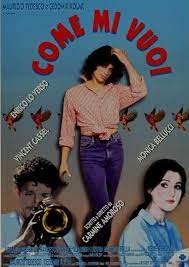
AS YOU WANT ME/COME MI VOUI
Italy, 1996, 100 minutes, Colour.
Enrico Lo Verso, Vincent Cassel, Monica Bellucci, Francesco Casalei, Urbano Barbarini, Meme Perlini.
Directed by Carmine Amoroso.
This is an Italian comedy of the mid-1990s, something of a curiosity item in retrospect. It appeared when there were more and more films emerging with gay themes, but also in the atmosphere of the AIDS epidemic.
This film seems to be offering a sympathetic perspective on homosexual orientation but focuses, especially, on drag queens. However, underlying the surface comedy, there is also the issue raised of the possibilities for intimate male/male relationships.
At the centre of the film is Domenico, who dresses as Desideria, in clubs, cruising with other drag queens, encountering the clientele driving up in their cars. Domenico is played by Enrico Lo Verso, longtime veteran of Italian cinema.
The police do their rounds, arrest the various drag queens, interrogations. One of the police is Pasquale, played by Vincent Cassel, who, it turns out, knew Domenico when they are at school. Pasquale is engaged to a young woman played by Monica Bellucci (a couple of years before Cassell and Bellucci were married in real life).
Then there is the sympathetic but interfering parish priest, eager to support Pasquale, fostering his relationship with his fiancee, aspects of comedy about sexual relationships. The priest seems rather horrified at the story of Domenico/Desideriaa, and encourages Pasquale to be supportive of him.
What follows, is a sexual relationship between the two, Domenico in love, Pasquale explaining the situation in a rather matter-of-fact way to the priest, to his fiancee, the possibility of the coexistence of the two sexual relationships.
So, this is a perspective from Italy in the mid-1990s. An interesting companion film would be An Almost Ordinary Summer from 2019, a story where two older men, with children, fall in love with each other with the children’s generation trying to undermine the planned wedding. This film also has the added value of two heterosexual actors (as were the two in 1996), Alessandro Gassman and Fabrizio Bentivoglio portraying the two older men.
Almost Ordinary Summer, An/ Croce & Delilizia
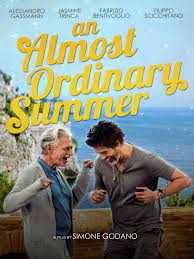
AN ALMOST ORDINARY SUMMER/ CROCE & DELIZIA
Italy, 2019, 100 minutes, Colour.
Fabrizio Bentivoglio, Alessandro Gassman, Jasmine Trinka, Filippo Scicchitano, Lunetta Savino, Anna Galiena.
Directed by Simone Godano
With such an English title, the audience anticipates how the summer will not be ordinary.
The film opens with the family joy, father and sons and daughter-in-law, pregnant, all driving off cheerfully to a summer holiday, finding the setup rather inadequate and complaining. The holiday centre is owned by a wealthy man who is celebrating his birthday and his daughters and various relations turning up.
So far, so expected.
However, there is a much more serious theme underlying the farcical aspects of the holiday. The owner of the mansion, Toni, veteran actor Fabrizio Bentivoglio, announces his intended marriage ceremony with Carlo, the father of the holidaying family, veteran actor Alexxandro Gassman.
Needless to say, the rest of the film is about the variety of reactions to this announcement, the film establishing the characters of the two older men, their meeting, the longtime partnership, each of them with family, but finding something in each other, especially the older man finding a genuine humanity in the widower, Carlo.
And, needless to say, there will be hostility to the wedding. It comes from Carlo’s son, Sandro, who reacts very badly, respecting his father but disagreeing with him. And there is hostility from Toni’s daughter, Penelope, Jasmine Trinka, who says that she campaigned and marched for gay marriage rights but does not want this for her father. She and Sandro team together to undermine the wedding.
What follows is holiday joy, family upsets, the arrival of Penelope’s mother, played by veteran Anna Galienay and, different attitudes, different understandings, an issue of Sandro’s younger brother, Diego, and whom he will stay with.
There are some very strong scenes, especially with Penelope’s panic attack and her being helped by Carlo.
There is some alienation, some reconciliation, and some happy sequences during the final credits of the wedding celebrations.
- An Italian comedy with a serious theme? The history of the legislation on gay marriages? In Italy? 21st-century perspective?
- The title, irony, on holidays and summer, at the water, holiday homes, carnivals, picnics, activities…? The musical score?
- The location, the coast, the beach, the holiday accommodation, the touch of the primitive, the mansion and the interiors?
- The focus on the family, loud, all together in the car, travelling to the holiday, the music and song? Arrival, the primitive conditions, toilet and shower, complaints? Settling in?
- The establishing of the family, Carlo as the patriarch, widower, his relationship with Sandro, Sandro’s wife, the younger brother, Diego, working class background?
- The mansion, Toni as the patriarch, wealth, lifestyle, Olivia and her arriving, spoiled movie star, Penelope arriving late, bumping the car, self-assured, the presence of the hunt and her boyfriend, Toni’s birthday, the meal?
- Toni and the tensions with his daughter’s, his never marrying, the long partnership, the other children, journeys to France, Olivia’s birth, arrival in Italy? Penny as his daughter, yet the tension between them?
- The situation: Toni announcing the wedding, the reactions, Olivia, the aunt and the boyfriend tolerant? Penny, her comments about campaigning for gay marriage but her not wanting this for her father? Carlo, wanting to find the time to tell his family, hesitating, Toni and Carlo together, Sandra seeing them, his violent reaction?
- Stances about the marriage, in three weeks? The two men explaining the background, Carlo and his meeting Toni at the hospital, talking, the meal together, kindred spirits? It is a completely different backgrounds, lifestyles? Carlo appreciating the older man? Toni admiring the inner depth of Carlo, sympathy and understanding?
- Audience response to the announcement, for or against the marriage, siding with the couple, siding with Penelope and Sandro?
- The comic situations, the serious situation? Penelope, her scheming, talking with Sandro, stopping the family leaving, wanting to undermine the relationship? The various stages, collaboration, developing and her problems, the advance on Sandro, his wife seeing it, the upset?
- The meals, the picnics, the couple together, the ups and downs, the barbecue, Carlo dancing, everybody joining in except Sandro? The joy of everybody dancing?
- The issue of Diego, young, to live with the couple? Sandro and his reaction? Sandro and his relationship with his wife, her pregnancy? Diego, the youngsters going to the carnival, their being lost, Carlo blaming Toni? The morning aftermath, explanations? Carlo and his decision that he would discuss the situation with Diego? Diego, young, the attraction to the young French girl, lovelorn, his father’s wise advice? Carlo coming to getting from Sandro, the going off together?
- The arrival of Penelope’s mother, not a marriage, her work in fashion, the plot to undermine the wedding, yet her encounter with Carlo, sympathetic, change of heart? Penelope’s disappointment?
- The confrontation, Sandra’s reaction, his wife’s reaction, Penelope’s humiliation, unable to breathe, the panic attack, Carlo and his sympathy, helping her to breathe, driving her, the frank talk, Penelope explaining her father’s ignoring of her?
- Carlo, going away, fishing? Toni, wanting to find him? Penelope helping, Sandro on the boat, meeting on the boat (despite the crew calling out about packets), the reconciliation – all round?
- The final credits, the ceremony, everybody joining in the celebration?
- The status of gay marriage in Italian society with its religious traditions?
Assassin Club
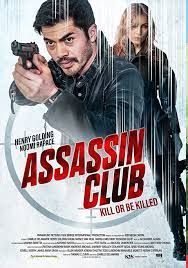
ASSASSIN CLUB
US/Italy, 2023, 111 minutes, Colour.
Henry Golding, Noomi Roopace, Sam Neill, Daniela Melchior, Jimmy-Jean Louis.
Directed by Camille Delamarre.
This is an action show, rather complicated, which serves as a pastime.
There is an interesting prologue, a scene between a father and daughter, then his assassination and her escape. Towards the end of the film, the audience will understand the significance of what happened, the assassin, the motivation, political repercussions in the Czech Republic.
However, the main focus of this film is on Morgan, played by Henry Golding who made such an impression in Crazy Rich Asians. Formerly in active service, he has been recruited to be an assassin, killer of evil people whom the law cannot touch. An orphan, he was to befriended by Caldwell who trained him and then is his controller. Caldwell is played by Sam Neill at his most British urbane style.
We see Morgan on the job, failing, attacked, almost killed. He has visits with Caldwell, is informed about a plan whereby a rich client has targeted seven assassins. We are soon informed that each of the seven assassins has been commissioned, with promise of $1 million per assassination, to eliminate the others. Morgan has encounters with various assassins, killing them, fighting them, making the agreement with a more sympathetic assassin who lives with his young daughter in Barcelona.
In the meantime, this seems to be a special secret government squad, led by Falk, Noomi Rapace, who has all kinds of agents at her control, all kinds of technology, and a link with police official played by Jimmy-Jean Louis.
One of the credibility drawbacks of the film is the comparative ease with which Morgan can move from assassination scene, from one country to another, and come back to his girlfriend in Rome. But when he has to disappear, he also has a secret apartment in Rome, which, with a eye identification, also holds a huge arsenal as well as an extraordinary amount of surveillance screens.
He is in contact with the leader of the official squad and they play cat and mouse interactions.
Eventually, the villain starts to be unmasked, the confrontation, very urbane then deadly, with Caldwell, the abduction of Morgan’s girlfriend, tied up in a bath with the tap on, and explosives with a timer
Since Morgan is the hero, and wants to avenge Caldwell’s death, as well as to rescue his girlfriend and defuse the explosives, there are some deadly fight sequences with the villain – but a final shot in the street, the bullet seen in close-up slow motion as the villain is killed.
Critical and blogger response to the film has been quite negative – but, as was said, it is an action-thriller, reminiscent of many other films, a time-passer.
Foe

FOE
Australia, 2023, 110 minutes, Colour.
Saoirse Ronan, Paul Mescal, Aaron Pierre.
Directed by Garth Davis.
From a novel by Iain Reid who collaborated with the director on the screenplay. It is a slow-burn drama, (some bloggers complaining that the fire took a long time even to kindle). However, for those who enjoy intriguing dramas, elements of the unknown, the probing of relationships, there is much to commend a careful watching of Foe.
Foe has a global theme, the continued destruction of planet Earth, ambitious moves towards settlements on other planets, preparations for work on space stations. It is 2065, frighteningly close to the present, the continuing barrenness of the planet and it should be so close. There are sequences of devastated countryside (filmed in Queensland, Victoria, South Australia). However, as with global filmmaking these days, the setting for the story is the midwest of the US (and with an Australian director, Garth Davis (Lion, Mary Magdalen) two Irish leads, and a British lead).
While it is important to focus on the futuristic, science-fiction aspects of the scenario, in many ways, they are quite secondary, simply offering the opportunity for the main theme, the exploration of a marriage. We see a couple who have been married for seven years, he on the property and in the house owned by his family for centuries, working in a large chicken processing plant, she working as a local waitress in a diner. Saoirse Ronan is Hen. Paul Mescal is Junior. The marriage is not always easy, Hen wondering about the affection of her husband, dreaming of something better. Junior seems to be satisfied where he is. Quite a lot of scenes between the two leads dramatising the tensions, ups and downs of the marriage. No children.
Then the science enters in the form of a government agent, Terrance, played by Aaron Pierre, very British in his delivery. The government has investigated the couple, wants Junior to spend a year on a space station, a sign of the future. He lets the couple ponder this for a year, then returning, the plan to go into action, and the proposal, definitely science-fiction here with artificial intelligence, robotics, and plans to create exact replicas, physical, mental, emotional, some company for Hen during her husband’s absence.
While the initial part of the film has been a probing of the marriage, this intensifies with Terrance’s presence, interrogations, tests, trying to understand each of the characters, the relationship, so that the substitute will be a proper companion.
While there is scientific success, there are some emotional complications, building up to quite a dramatic conclusion, surprising dramatics, and the final solution which we may have been anticipating.
There is very little futuristic technology seen in the film, that being kept to the very end. Rather, this is a psychological study of two people in a futuristic setting and challenge. And a slow-burn.
(Recently, with the same time sitting, a more elaborate conflict between humans and AI creations was seen in The Creator.)
1. Title? Enemies? Marriage? Interaction between Hen and Junior? Terrance as a foe?
2. Science-fiction? Earth and its destruction? Survivors? Quality of life? Space travel, space stations, a future?
3. Artificial intelligence, robotics, clones, the creation of perfect copies, physical, emotional, mental?
4. 2065, not so long into the future? The possibilities of Earth degradation? The possibilities of technological development?
- The settings, filmed in Australia, the American midwest, barren plains, vast open spaces, no rain, poor crops, the Homestead from the past, the elaborate chicken factory, the diner? The musical score?
- The picture of the marriage, seven years, Hen in the shower, voice-over, pondering Junior’s love for her or not? His being rooted in the area, pride, family? Her work in the diner? His work in the chicken factory? Life at home, his storing everything, the piano, her love of playing, Junior not wanting her to play? The change, playing, consistent – then destroying the piano?
- The arrival of Terrance, the car, isolated area, the government, his proposal, their reactions? His building up the possibilities? His return after a year?
- The process, interviews with Junior, Terrance getting to know every aspect of his life, the scenes of interrogation, the physical tests, psychological tests, emotional tests? The effect on Jr? The effect on? Criticisms, observations, becoming more involved? Terrance and the intrusion into their lives, talk, drinking, the attraction?
- The scenes of ordinary life, the chicken factory, the diner? The episode of Junior out in the fields, the flying saucers, his being injected, his returning to the house, the confrontation?
- The twist in the plot, the government preparing the complete replicant, the confrontation between the two, the humanity of the replicant, Junior returning from the space station, detached? The effect on Hen, the companionship with the replicant?
- Terrance, the crew, technology, observations, the scene of their toasting their success?
- The replicant, his humanity, the pathos of his last moments, the death, the corpse?
- The aftermath of the marriage, Hen and her comments about leaving the envelope, the blank page inside? Her explaining her ambitions to do more, Terrance and his sympathy?
- Hen, her disappearance, Jr by himself, the reappearance, more formal, learning, the indication that she did not have all of Hen’s knowledge, Junior accepting her as companion?
- Hen, in the plane, the pass comments about air travel, her leaving behind her replicant, going on a personal quest?
Veronica
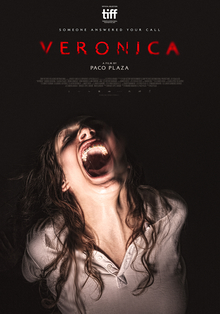
VERONICA
Spain, 2017, 103 minutes, Colour.
Sandra Escacena, Bruna Gonzalez, Claudia Placer,Ivan Chavero, Ana Torrent, Consuelo Trujillo.
Directed by Paco Plaza.
Spanish writer-director, Paco Plaza, has been interested in eerie themes, especially in his series, Rec.
This time he goes to Madrid, 1991, a family, working mother (played by former child star, Ana Torrent, Spirit of the Beehive, Cria Cuervos), Veronica, aged 15, who misses her dead father, and three younger children, two little girls and the bespectacled, wide-eyed little boy.
The children go to a Catholic school, and a nun in more contemporary habit giving a class on a forthcoming eclipse which everybody watches. However, she introduces and a very elderly nun, blind, gaunt, in an old habit, Sister Narcisa whom the children nickname as Sister Death. She will reappear influencing Veronica.
But the key to the film is Veronica’s having a Ouija board and persuading two of her school friends to play with the board, to contact her father, while everybody else is watching the eclipse. There are some disturbing moments, Veronica collapsing. She continues to be preoccupied with the Ouija board which is split, her looking up magazines to get more information, painting of Viking symbolic image. She is also challenged by Sister Death, as well as her mother.
Eventually, there is ghostly presence, sinister and threatening, the little girls having to be evacuated from the house, the capturing of the little boy then his rescue, Veronica confronting the strange presence and cutting her throat.
The film opens with the police arriving and ends with the inspector writing his report, allegedly the film based on this report.
Five years later, Paco Plaza took the theme of Sister Death, Sister Narcisa, and made a prequel with a history of the elderly nun, its final scene back in the classroom in 1991.
- Spanish horror? Catholic traditions? Ouija board and contact with the dead? Supernatural consequences?
- Madrid, the city, apartments, restaurants, school, convent? The musical score?
- The opening, the dead, the police, atmosphere, flashbacks? The screenplay allegedly from the detectives notes? The end, his writing, his disappearing, the police backing out? Sinister?
- The title, the focus on Veronica, aged 15, the family, the death of her father, memories, the photo, the pizza? Wanting to contact him? The two little girls, characters, age, phone communication, creative play? The little boy, his eyes, the glasses? Their mother, busy, Veronica happy to take responsibility?
- The background of the eclipse, the nun and the classes, needed to bring the negatives to see the eclipse? The excitement of the children? On the roof? Veronica and Rosa, meeting Diana, the going to the basement, Veronica with the Ouija board, the experience, eerie, the effect on Veronica, the other two girls leaving? Veronica taking the Ouija board, broken, hiding under the bed? Her research of the magazines, the diagram with the Viking signs, discovering that the ceremony had to be complete, the farewell?
- Veronica, the effect, her encounter with Sister Death, smoking, talking, memories, teaching, seeing without her eyes? Sister Death in the basement, the final talk with Veronica, the advice?
- The device of nightmares, Veronica, graphic, the presence in the house, choking her sister, sinister experiences? Waking?
- Veronica and the responsibility for the children, taking them to school, their mother? Veronica going to the restaurant, wanting to communicate? The leftovers for the meal? At home?
- Veronica, her fears, the presence in the house, gathering the children into a room? The bizarre behaviour, her mother’s return, denials?
- The buildup to the combination, Veronica with the Ouija board, the presence in the house, her ringing the police, their arriving, the little girls out of the house, with their mother, the little boy, taken by the presence, in the cupboard, the final experience of Veronica, slashing her throat?
- Her body taken out, the mother with the children, the police and its effect?